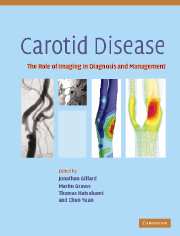Book contents
- Frontmatter
- Contents
- List of contributors
- List of abbreviations
- Introduction
- Background
- Luminal imaging techniques
- Morphological plaque imaging
- Functional plaque imaging
- Plaque modelling
- Monitoring the local and distal effects of carotid interventions
- 25 Transcranial Doppler monitoring
- 26 Imaging carotid disease: MR and CT perfusion
- 27 Near infrared spectroscopy in carotid endarterectomy
- 28 Single photon emission computed tomography (SPECT)
- 29 Monitoring carotid interventions with xenon CT
- Monitoring pharmaceutical interventions
- Future directions in carotid plaque imaging
- Index
- References
25 - Transcranial Doppler monitoring
from Monitoring the local and distal effects of carotid interventions
Published online by Cambridge University Press: 03 December 2009
- Frontmatter
- Contents
- List of contributors
- List of abbreviations
- Introduction
- Background
- Luminal imaging techniques
- Morphological plaque imaging
- Functional plaque imaging
- Plaque modelling
- Monitoring the local and distal effects of carotid interventions
- 25 Transcranial Doppler monitoring
- 26 Imaging carotid disease: MR and CT perfusion
- 27 Near infrared spectroscopy in carotid endarterectomy
- 28 Single photon emission computed tomography (SPECT)
- 29 Monitoring carotid interventions with xenon CT
- Monitoring pharmaceutical interventions
- Future directions in carotid plaque imaging
- Index
- References
Summary
Introduction
History and development of transcranial doppler (TCD)
The idea of investigating the intracranial circulation with ultrasound was first proposed in 1960 by Kaneko working in Osaka while developing the clinical uses of sonography (Kaneko, 1986; Satomursa and Kaneko, 1986). At that time the skull was considered a significant barrier to the penetration of ultrasound and the investigators chose to concentrate on investigating the extracranial circulation instead.
However the problem can be minimized by using a lower frequency of ultrasound and utilizing areas of the skull where the bone is thin enough to allow ultrasound waves to penetrate. Fortunately, one of the areas of thin bone is located in the temporal region and this area allows insonation of all the main cerebral arteries arising from the circle of Willis, namely the anterior cerebral, middle cerebral and posterior cerebral arteries. The middle cerebral artery (MCA) is particularly important as this is the main blood supply to the parietal area of the brain which contains the main motor and sensory cortices, the most important clinical areas affected by stroke.
The first transcranial Doppler recordings were performed by Rune Aaslid in the Department of Neurosurgery in Bern in the summer of 1981 utilizing a 2 MHz pulsed Doppler machine originally designed for cardiac use (Aaslid et al., 1982). Today, advances in microprocessor technology have enabled the development of specialized systems which have helped to establish TCD as a useful method for studying cerebral hemodynamics and detecting cerebral embolization in a wide variety of clinical and research situations.
- Type
- Chapter
- Information
- Carotid DiseaseThe Role of Imaging in Diagnosis and Management, pp. 341 - 357Publisher: Cambridge University PressPrint publication year: 2006



